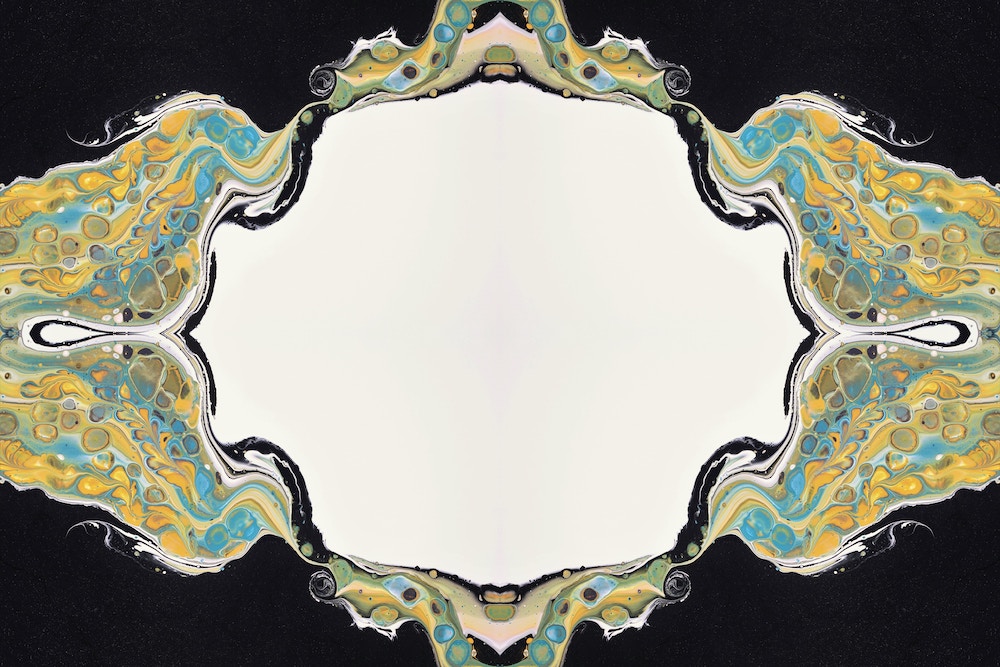“A Picture is Worth a Thousand Theories”: The Importance of Minoan Iconography
by Danielle Kirby, Anthropology
Minoan Iconography at the beginning of archaeology was perceived at face-value. During a period called “culture history,” archaeologists focused on categorizing artifacts into groups instead of assigning meaning. Instead, they found meaning through evidence from ancient text. But as time went on, archaeologists began to take a second look at frescoes. From this second glance it has been determined that nature scenes held an underlying religious tone. This has paved new ways for the identification of frescoes. But due to the change in categorization sites have been subjected to debate as they could have been used for more than one purpose. It was found that their biases impacted the identification of some sites and how the Minoan was perceived. Considering these biases and new inferences, these frescoes were not just a pleasant sight but were a political tool used by the upper class. The upper class used the imagery as evidence of favor from the gods to cement their status above the lower class.
Minoans, Archaeology, Imagery, religion, Knossos, Classics
Whether it be to convey the emotions of one’s love or to record the natural landscape, humans have been painting for thousands of years. Paintings connect the viewer to the painter, to their home, and to what they feel as the paintbrush moves against its medium. From the lofty ceilings of the Sistine Chapel depicting images of Christ, to the crypts of ancient Egyptians depicting the way to the afterlife, paintings are crucial evidence that archaeologists can use to understand civilizations of the past. Minoan paintings give insight to the present stories passed down through oral traditions and practices. This is especially true for the Minoan society that once thrived on modern-day Crete. Archaeologists can better understand the Minoan religion due to symbolism in their iconography. At a glance these frescoes are just decorative paintings of the nature one sees outside. But after a second glance, there is more that can be seen, like the religious nature of these nature scenes and how the elite used the paintings to cement their status.
Background
Over 5,000 years ago, three civilizations ruled over modern-day Greece in a time known as the Bronze Age Aegean (3000 BCE – 1100 BCE). These three civilizations were the Myceneans located on mainland Greece, the Cyclades that spanned the islands in the Mediterranean, and the Minoans on an island that today is known as Crete (Hemmingway 2012). The Mycenaeans are the most well-known of the trio, as their history was written down by scholars like Homer (Muhly 2010). The most well-known works are still read today, the two most prominent being the Iliad, which is about the Trojan war, and the Odyssey, the tale of a hero named Odysseus fighting mythical creatures to get back home after the Trojan war (Muhly 2010). Along with these two tales their mythology was recorded in their language, Linear B. One of the numerous myths, the Minotaur, and the labyrinth, is thought to be the Mycenaeans’ depiction of the Minoan civilization on Crete.
Archaeologists know less about the Minoans, due to the loss of their written language, Linear A. Because of this we rely on their wall paintings called frescoes, the architecture, and other artifacts found during excavations (Hemmingway 2012). The most well-known excavation is at the palace of Knossos, a large administration building in the Minoan capital of Knossos. The city of Knossos still retains its old name. It was excavated in the early 18th century by an archaeologist named Sir Arthur Evans as he was trying to uncover the palace of King Minos, who the Minoan civilization was named after (Muhly 2010).
The Beginning of Archaeology
When these excavations of the Bronze Age Aegean began, archaeologists focused on the face-value of artifacts with little theory use. Archaeologists studying the bronze Aegean were fortunate enough to have remnants of texts from the past to help guide the research done in the present (Wace 1949; Muhly 2012). When handling an excavation, archaeologists like Heinrich Schliemann, who is thought to have found the remnants of the ancient city Troy, would just use ancient works like Homer’s Iliad to understand the context of the site (Marinatos 2015:11). Along with this text, there have been a myriad of artifacts from excavations that can help piece together the history of ancient civilizations. These artifacts could range from a small pottery sherd to big fortifications like the palace of Knossos or the walls at Mycenae. In lieu of all these finds, archaeologists were more focused on how to separate these artifacts, for surely all these sherds of pottery from a site did not come from the same time period. Thus, Culture history began, using artifacts to help create a linear timeline for the past.
The culture history timeline can be separated into three sections: The Stone Age, The Bronze Age, and the Iron Age (MacEnroe 1995: 4) Within these three sections there can be subsections that record different lifespan of civilizations, helping form a framework to show what societies were present during the same dates. To create these three time periods, archaeologists would inspect the differences in the creation and artistic designs of different ceramic works to determine their date of origin (Hemmingway 2012). Once dated, the ceramic shards can then be categorized to help form the frameworks of the past. These frameworks and dating techniques are so crucial that some archaeologists like Alan Wace have stated that all they need to properly date an excavation site was fragments of ceramics (Wace 1949:11). If a ceramic piece with features consistent with ceramics created in Crete was found in Cyprus, then it was a sure-fire way to show that these two societies had traded with one another (Kantor 1947: 18).
In Minoan archaeology the identification and classification of artifacts was extremely important as archaeologists did not have text to help corroborate stories like the Mycenaean Region of the Aegean. The Minoans did have a written language text called Linear A; however, it still has not yet been translated like the Mycenaean Linear B. The excavation on Crete is where one begins to see the semblance of theory come into play. The most recognizable site in Crete is the palace of Knossos which was excavated by the prominent British archaeologist Sir Arthur Evans (Muhly 2012). He was one of the first to look past what one could see and introduced theories about religious motifs in the Minoans’ illustrations and symbols, known as iconography. Sir Evans noticed how some icons that could have been used purely for decorations could instead be interchangeable with religious symbols in Minoan culture (Marinatos 2015:16). He first presented this in his work Mycenaean Tree and Pillar Cult and Its Mediterranean Relations in which he discussed a set of caves in Crete that had a religious purpose due to certain features like an altar in one (Evans 1901).
Sir Evans’ main example was how on signet rings, trees can denote a sacred space. A set of trees could represent a sacred grove, or palm trees in front of the building can signify that the building is a temple (Evans 1901:103). Signet rings are a type of jewelry where instead of a precious stone like we have today, the ornament would be a piece of stone that had a design engraved onto it. These rings could then be used as a stamp to identify a person on documents like a signature (Weingarten 2012). Just like jewelry today, Evans proposed that the designs could have a religious meaning, such as how Christians will wear the cross of Jesus as part of a necklace. The Cross by itself just looks like a pair of crossed lines, but with context it is an important religious symbol. At first glance, the palm trees on signet rings may just be decorations. However, in context, these trees instead had religious significance.

A set of palm trees could instead signify the pillars to a religious temple (Evans 1901:101). But not only can the prescence of these palm trees show a religious nature, but also the size of these trees. If a figure in the signet tree was larger than these trees or larger than other people, then the figure was deemed to be a deity (Marinatos 2015:27). With these new distinctions, other archaeologists began to take a closer look at these imagery associations on the signet rings. They not only looked at what was on the ring, but how it was arranged.
Archaeologists also began to look for categories not only in signet rings but also in frescoes. Archaeologists point out how important religion is to the Minoans and that some frescoes have direct representation like the rings. One fresco shows an altar with bull horns, a religious symbol along with the bull itself, while frescoes at Knossos are thought to depict a woman who is a goddess of nature (Rehak 1997:164; Adams 2017:49). Due to this, frescoes were separated into two groups to better understand their context: secular and religious. Frescoes with depictions of nature or everyday life were considered secular and just seen as decorations (Chapin 2004:48). If the frescoes had depictions of humans, potential rituals, or anthropomorphic beings, then they were religious (Adams 2017).
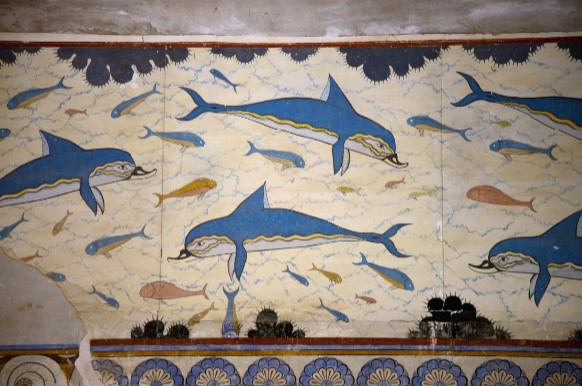
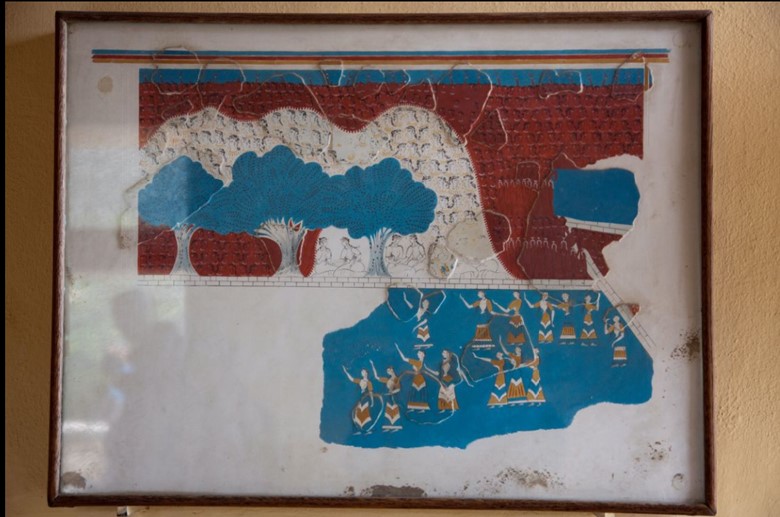
By distinguishing between the frescoes’ use, it allows archaeologists to understand the purpose of the room that holds these features. If a room holds one of these religious frescoes, then it can be deduced that the residents used this space for rituals. If it had a more nature-focused fresco, then there would be more options for the use of the room, like a dining room or a bedroom.
Second Look at the Art
However, the distinction between these two groups of frescoes and their context began to change when people started to dispute the early archaeological interpretations. In the 1980s, an archaeologist named Darcque decided to dispute the function of a site in Eleusis, Greece known as Megaron B (Cosmopoulos 2003:1). Instead of being a temple for Demeter, Darcque argued that due to issues in continuity and architecture. For instance, one argument states that the walls are grouped incorrectly, as walls 3 and 5 should be together destroying the religious evidence that Megaron B was enclosed (Cosmopoulos 2003:13). Due to these arguments, Darcque proposes that the building was primarily used as a residential home instead of a temple. These critiques are due to the issue that classification can limit sites and artifacts to only one dimension and one purpose. Just as people can do multiple tasks, so can artifacts. At Eleusis, the artifacts found could be used for rituals, but there is nothing special to distinguish them from objects that could be used in everyday life (Cosmopoulos 2003:15). Megaron B could be a residential home that was also used for worship. The altar in the building had its own multipurpose, as it also helped support the building (Cosmopoulos 2003:8). These double uses make it hard to distinguish the categories given at the first glance.
The meaning of frescoes was also becoming a subject of argument as new interpretations arose. In the early half of the 20th century, frescoes of nature were thought to be only used for decorations. However, archaeologists in the latter half of the century disputed that these frescoes could have underlying religious motifs (Rehak 1997:164). In the past, Archaeologist pointed out the direct representation in Minoan frescoes. In a fresco from a royal villa, one can see a woman next to an altar (Rehak 1997:165; Adams 2017:49).
However, some archaeologists believe that the religious context may be more discreet in the form of symbolism. This is due to the importance of nature in the Minoan religion.

In the Minoan religion, there is a strong relationship to nature. The people practiced their religion using sanctuaries situated in mountains, natural formations known as peak sanctuaries, and the presence of sacred caves (Lupack, 2012). The prescence of female deities also coincides with this, as females are associated with seasonal cycles and fertility (Lupack 2012; Rehak 1997:171). Because of this important relationship to nature, it is thought that some frescoes depicting the natural world, such as a landscape scene, could hold religious importance (Rehak 1997:171). Certain flora and fauna were now thought to have an underlying link to religious practices. Lilies and crocuses were deemed religious because they were regularly depicted as offerings or decorations for altars (Chapin 2004:48). In modern literature, a red door can have an underlying meaning of love or rage. The same goes for these floral decorations, where having a lily in a simple painting can mean a devotion to the nature deities.
The Delta 2 Room Debate
Because of the emergence of these religious underlying meanings, the designation of some sites has come into question. On Thera, modern-day Santorini, there is an archaeological site called Akrotiri. Akrotiri was a small town on the coast of Thera that was almost perfectly preserved due to a volcanic eruption, covered by ash like the famous town Pompeii (Collection of Antiquities of Thera). In Akrotiri, there is a room known as Delta 2. Delta 2 was a room decorated with a fresco which encompassed three of the walls. The fresco details a nature scene full of hills with lilies appearing from them with swallows flying above. Part of the wall is separated by a shelf, with the portion above painted completely red (Collection of Antiquities of Thera).
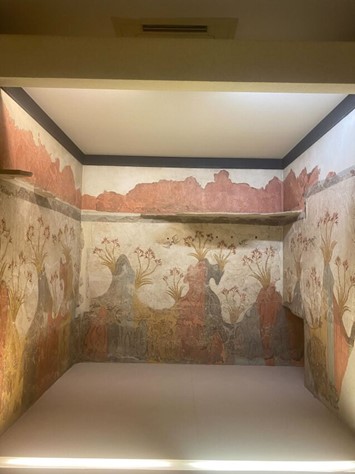
Archaeologists have debated whether this room is a bedroom or a shrine room. The point of contingency is the spring fresco. One side argues the frescoes are just a decoration in the room like how in modern days we have paintings of scenery hanging in our house (Hollinshead 1989:339). However, others dispute that lilies and flying swallows have underlying religious implications and were a background for rituals. Because of the underlying religious tone found in other frescoes, having just the fresco is not enough to fully determine the primary use for the room.
Just like Megaron B, there were artifacts found in the room. But like before, these artifacts could have more than one purpose. (Chapin 2004:49). There is one artifact in particular that has been subject to this debate. In this case, the ash from the volcanic eruption preserved a wooden artifact. Though the wood had deteriorated, archaeologists put plaster inside to recreate the structure (Collection of Antiquities of Thera). The artifact looks like a modern-day coffee table, having four legs that help connect four rods to create a rectangular shape. In the two longer rods there were indentations along its longer edge, where cords were netted together (Collection of Antiquities of Thera).
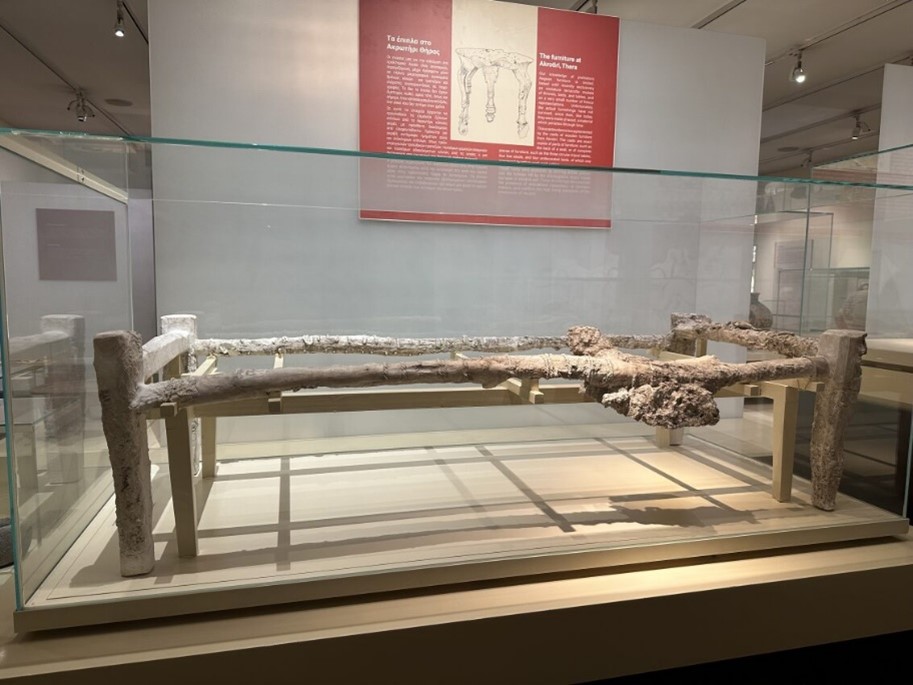
Archaeologists theorized that this structure was a bed based on the cords and indentations (Collection of Antiquities of Thera). Under this bed were jars, other ceramics, and tools used in everyday use (Hollinshead 1989:351). The mundaneness of these artifacts is what proposes Hollinshead and others to assume it was a common room like a bedroom. However, one must look back to Cosmopoulos’s point that though the items may be mundane, they may have had a dual purpose. Remnants of barley were found in the jar, and it is theorized that the barley could have been used as a sacrifice to a goddess dealing with nature. The ceramics may have played a role too (Hollinshead 1989:351). We see this in the use of the mundane in modern day religions. A cracker, a food people usually have as an afternoon snack, can represent the body of Christ, making it crucial for worship in Christianity. Many things in modern times can have numerous uses, so one must remember the same can be said for products used in the past. The archaeologist supporting delta 2 as a religious room supports the idea of multipurpose, theorizing that this bed structure is instead used as an altar (Chapin 2004:49). Though there is still a debate, archaeologists are now reexamining their predecessor’s work to get a better understanding of how to categorize and identify these sites.
Biases from Generations Before
As modern-day archaeologists try dismantling these categories that limit societies to a two-dimensional perspective, they re-examine their predecessors’ interpreted sites and what could have influenced their research. By doing this, archaeologists have been able to identify the biases that may have affected the work they did. Before, archaeologists only had to take the artifacts at face-value to understand their purpose. There was no use worrying about what could affect their perspectives. But as one goes to take another glance, they must also consider why the iconography was described in the fashion they were.
One of the major biases comes from the benefit of having numerous pieces of evidence. While it is helpful to have a myriad of artifacts, it comes as a double-edged sword. As sites have been uncovered in Greece over the years, there has always been the low hanging fruit of having numerous texts such as the Iliad (Muhly 2010). With this information, facts were used to fit a theory instead of using theory to understand facts. Archaeologists connected symbols from the Minoan to those on the Greek mainland from the Mycenaeans. The clay figures were said to be Hera, and Mycenaean temples were given ownership to characters who may not have been real, like the palace of Nestor in Pylos (Marinatos 2015:11; Muhly 2010). By only taking notice of this association early on, these pieces lose the underlying motifs that were attached. If a sculpture is thought to be the incorrect goddess, then the symbols will not be recognized for their true meaning.
Sir Evan’s biases have greatly impacted the interpretation of Knossos, as Sir Evans saw the building as a palace where Minoan monarchs would live. At Knossos Sir Evans interpreted a room to have a throne and so it was said to be used by the rulers of Crete (Adams 2017:49). The idea of a throne room and these ‘palaces’ implies that there was a singular ruler.
Sir Arthur Evans was influenced by the myth of the labyrinth; hence Sir Evans called the civilization the Minoans after King Minos who ruled over the residing place of the mythical maze (Marinatos 2015). But when taking a second look at Minoans, there is an absence of evidence for a singular ruler, with no fresco images depicting one. It is instead thought the ‘throne room’ was used for rituals and the ‘throne’ itself added in at a later date. (Nakassis el. al 2012). However, the myth itself is unreliable as it is thought that the monster the minotaur was just a way for the Myceneans to remember that bulls were important to the Minoans and that the labyrinth was the building Knossos.
The perspective is not only affected by the text, but also by his upbringing as seen with the monarchal interpretation. Sir Arthur Evans was born and raised in the United Kingdom. The theory stems from a ‘throne’ that was found in a room of Knossos. What made it stand out as a throne was that this piece of furniture was made of stone. Seeing this singular stone chair, Sir Evans proposed it was like how the monarchs in modern times had thrones. The United Kingdom, and many other European countries, have or once had a monarch and because of this, there is a multitude of palaces and castles strewn across Europe (Marinatos 2015). Sir Evans connected the imagery of an enormous building and inferred that it meant there was a monarchy that inhabited the building, just like the ones he had seen at home like Windsor Castle.
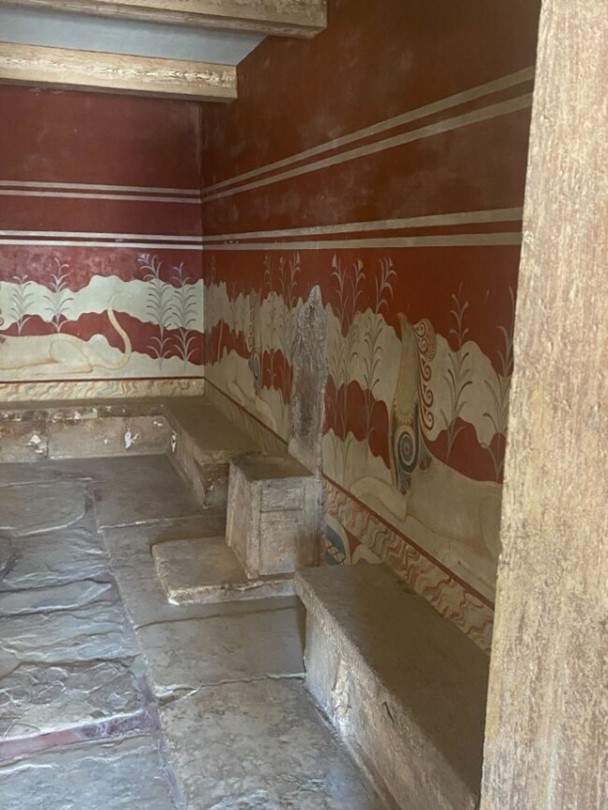
Not only did his past affect his perspective, but the present affected archaeologists’ perspective on Minoan civilization. Sir Evans and other archaeologists were conducting research during the World Wars, a time of political turmoil. The archaeologists of this time projected their wishes for a more peaceful time onto the frescoes in Knossos. Since the frescoes lacked scenes of war or violence against women and instead depicted scenes of nature, it was seen as a sign that the Minoans lived in a utopian-like society. Archaeologists theorized that for the Minoans, war did not lurk over the people’s heads like during the first half of the 20th century (Marinatos 2015:42). Chapin also notes that because Sir Evans lived in the Victorian era in which portraits of landscapes were prevalent, he would have thought the same was true for the Minoans (Chapin 2004:48; MacEnroe 1995:3). This fashion style was not the only factor from this time, as this was also when the theory of evolution was being constructed (MacEnroe 1995:4). People began to see a series of stages not only coming from evolution but from other parts of history. Sir Evan’s father was an archaeologist who was key in the creation of the theory of evolution. Growing up with his father’s knowledge and works, Sir Evans human history in stages, three different stages which are still being used to this day (MacEnroe 1995:4). With all these biases combined, it gives better understanding to why these sites were interpreted as they were. While conducting research, one uses what they know to help create a vision of the past. While that happens, our previous experiences and knowledge find their way into these interpretations. We may not be able to escape our biases, but it is crucial to be aware of and to identify them so that as theory grows as our knowledge does instead of being hindered by how the world used to work.
Iconography as a Political Force
As archaeologists have deconstructed old interpretations and considered their predecessor’s biases, there have been debates on how the different dimensions of artifacts have come into play with human interactions. Archaeologists have started looking into different philosophical ideas like Marxism, trying to better understand the struggle between different classes of people. Specifically, there has been discussion about how artifacts were used to portray a person’s status in society. Voutsaki (1997) writes about how the upper class used gift-trading as a way to establish their place in society. The history of a gift and the labor put into its creation was used to show one’s status. If the gift is over-the-top and has high detail, it shows how the gift-giver has a considerable sum of money that can be used to create such a lavish piece (Voutsaki 1997). It is so prevalent that we see evidence in the Odyssey, as Telemachus is given a mixing bowl by Menelaus (Lattimore 2007:81). As Menelaus gives him the bowl, he mentions how the bowl was created by Hephaestus, the god of craftsmanship himself. Menelaus then goes on about how he had once been given the bowl by another hero earlier in his life (Lattimore 2007:81). By doing this, Menelaus and other aristocrats would be able to show who they are connected to, and how they can pay for ornate items. The more detail and stories attached to a gift, the higher the person was in status. It shows while the parties have a beneficial relationship, the guest should be respected because of their higher status being shown through the gift.
Not only did Minoans display wealth with gift-giving to others, but also gift-giving to the gods. Instead of offering clay figurines, lead and bronze sculptures were offered as a type of elite offering to the Minoan pantheon (Hemmingway 2012:28). Just like many other cultures, the Minoan elite used religion to assert their superiority. Some palaces were constructed so that no unwanted onlookers could see in, and if they dared to enter the compound, they would be intimidated by the entrance (Adams 2017:44; Rehak 1997:169). With this architecture, the upper class could then have power over religious ceremonies and separate the people in control from those observing (Chapin 2004:61). Separation in religion was then used to create a religious upper class, who would not only control the rituals but also the government (Chapin 2004:61).
The same exclusion pertained to religious frescoes. Archaeologists have determined that many of these frescoes were located in residential houses on the upper floor (Adams 2017:212; Chapin 2004:51). This meant that only the upper class were able to see the exquisite art, and they could control who might have access to it. With this control, the owners of the art can use this religious evidence to show why they are of such a high status. Chapin notes how if a member of the lower class were to see the works of art, it would have been as if the owners were showing the guest a slice of divinity. This power over the lower class allowed the upper class to assert dominance once again as the gods has chosen to gift them with this power (Chapin 2014:61). If the lower class did not have access to these replicas of nature and rituals, then who are they to question their higher ups? It is like how in modern times, the English monarchy had a direct connection to God and that is why their lineage ruled over the country. By having this religious status, the monarchs improved their social status, allowing them to maintain their rule with little to no objection. King James I used the divine right of kings to cement his rule, showing how important and powerful religious justification can be.
Conclusion
Though classical archaeology is still dependent on the multitude of artifacts and texts for context, archaeologists have started to fill in the gaps in those texts with theories. These theories allow the sites and artifacts to become complex from the limits imposed upon them. Though we do not have the translations of Linear A, the illustrations left behind can help understand the Minoan civilization. The Minoans iconography can be used to help form theories on the agency of the Minoans and how it once was. Like Henrik Ibsen once said, “a picture is worth a thousand words.” Not only do these frescoes speak a thousand words, but they help create a thousand theories. If we take everything at the first glance, then there is so much meaning that could be left out, changing how one sees the world or these frescoes. But by taking the time to inspect these sites, more meaning can be found. There is so much context to an image that creates its value, like how it was interpreted and what was meant to be interpreted. Hidden meanings come to life like the live lilies signifying ritualistic purpose. In that new context, a better understanding can be found and help interpret the world we live in. That is why it is key to not take everything at face value, but instead to take another glance and see what lies beneath and what theories can form.
References
Adams, Ellen
2017 Cultural Identity in Minoan Crete: Social Dynamics in the Psychological Neo-Palatial Period. Cambridge University Press, New York
Chapin, Anne P.
2004 Power, Privilege, and Landscape in Minoan Art. Historia: Zeitschrift Für Alte Geschichte 18(3):257–75. http://www.jstor.org/stable/1354062, accessed 13 Apr. 2023.
Collection of Antiquities of Thera [Exhibition]. National Archaeological Museum, Athens.
Cosmopoulos, Michael B.
2003 Greek Mysteries: The Archaeology and Ritual of Ancient Greek Secret Cults. Routledge, London.
Evans, Arthur J.
1901 Mycenaean Tree and Pillar Cult and Its Mediterranean Relations. The Journal of Hellenic Studies 2199–204.
Hemmingway, Sean.
2012 Art of Aegean Bronze age. The Metropolitan Museum of Art Bulletin 69(4):23-39.
Hollinshead, Mary.
1989 The swallows and Artists of Room Delta 2 at Akrotiri, Thera. American Journal of Archaeology 93(3)339-354.
Kantor, Helene J.
1947 The Aegean and the Orient in the Second Millennium B. C. American Journal of Archaeology 51(1):1-103.
Lattimore, Richmond
2007 The Odyssey of Homer. Harper Perennial Modern Classics, New York.
Lupack, Susan
2012 Minoan Religion in The Oxford Handbook of the Bronze Age Aegean (ca. 3000 – 1000 BC), edited by Eric H. Cline, 251-262. Oxford University Press, New York.
MacEnroe, John
1995 Sir Arthur Evans and Edwardian Archaeology. The Classical Bulletin 71(1):3-18.
Magal, Samuel
Minoan Palace, Queen’s Megaron. (Built around 1900 BC; destroyed by an earthquake ca. 1700 BC, and immediately rebuilt; captured by Mycenaeans around 1450 BC but survived undamaged; final destruction by fire around 1200 BC; Most of the ruins belong to the Second Palace Period). https://jstor.org/stable/community.15250261.
Marinatos, Nanno
2015 Sir Arthur Evans and Minoan Crete. I. B. Tauris & Co. Ltd, London.
Muhly, James D.
2012 History of Research in The Oxford Handbook of the Bronze Age Aegean (ca. 3000 – 1000 BC), edited by Eric H. Cline, 3-10. Oxford University Press, New York.
Nakassis, Dimitri, Michael L. Galaty, and William A. Parkinson
2012 State and Society in The Oxford Handbook of the Bronze Age Aegean (ca. 3000 – 1000 BC), edited by Eric H. Cline, 239-250. Oxford University Press, New York.
Rehak, Paul
1997 The Role of Religious Painting in the Function of the Minoan Villa: The Case of Ayia Triadha. Swedish Institute of Athens 40:163-174.
Ring (signet; electrum; impression)
(ca. 1500 B.C.). [Metal.]. Athens: Mus., National Archaeological.; From a tomb in Thebes. https://jstor.org/stable/community.11657022
Voutsaki, Sofia
1997 The Creation of Value and Prestige in the Aegean Late Bronze Age. Journal of European Archaeology 5(2):34–52.
Wace, Alan J. B.
1949 Mycenae: an archaeological history and guide. Princeton University Press, Princeton.
Weingarten, Judith
2012 Minoan Seals and Sealings in The Oxford Handbook of the Bronze Age Aegean (ca. 3000 – 1000 BC), edited by Eric H. Cline, 317-328. Oxford University Press, New York.
Acknowledgements
To my Opa, who always supported my passion.
Citation Style: SAA
